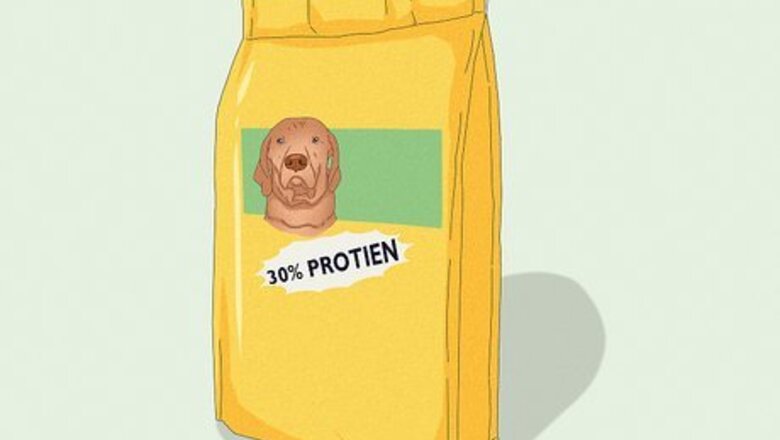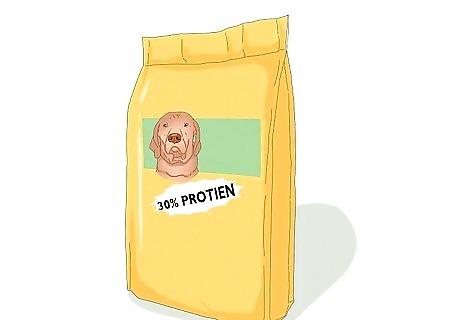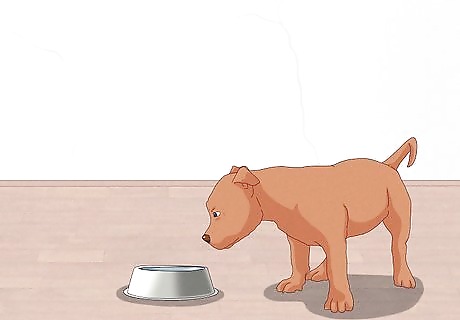
views
- Feed your Bully puppy 3-4 times per day from 12 weeks old to 6 months, and 2 times per day after.
- Opt for a premium puppy food with at least 20% fat content and 30% protein content, such as Bully Max to ensure that your Bully grows to be healthy and strong.
- Consult with your vet to determine whether your Bully pup would benefit from the addition of a vitamin, mineral, or protein supplement based on their unique health profile.
Selecting a Premium Dog Food

Select a food that contains at least 30% protein content. American Bully puppies need to start packing on muscle within the first few months of their lives, so the food they consume must have enough protein to allow them to start bulking up. As a general rule of thumb, the first 3 ingredients listed should be meats like beef, chicken, or liver to ensure your sweet Bully gets the high protein content they need to thrive. The packaging on your puppy food should clarify how much protein it contains. While some Bully owners supplement their dog's diet with raw meat, major veterinary bodies such as the AVMA and the Food and Drug Administration do not recommend this practice. Raw food poses risks of infection and can throw off a Bully's nutritional balance, leading to some deficiencies.

Choose a food that contains at least 20% fat content. Like all puppies, young Bullies need plenty of fat in their diet. A 20% fat diet will keep your pups healthy and allow their bodies to grow and form optimally. Plus, a high-fat content will allow your Bully puppy’s body to break down the proteins and nutrients they need easily. Giving your Bully pup foods with less than 30% protein and less than 20% fat content may result in health problems like muscle atrophy when the dog is fully grown. Popular Bully food includes Taste Wild High Prarie puppy food, Bully Max puppy food. Generally, dry food is better than wet food because it supports a healthy mouth free of tartar and periodontal issues. Some bully owners prefer to make their own dog food for their pup, including hearty stews and cooked meats. While this is possible, check with your vet first to ensure that whatever you’re feeding your Bully meets their health needs.

Talk with your veterinarian about what type of food is best for your Bully. Bullies are dog breed with specific food needs, so consult a veterinarian about what food is best for your dog's unique health profile. Overall, a Bully's diet must be a well-balanced mix of the following, all of which can be provided by selecting a high-quality food that your vet approves of: Fats: Aids your Bully’s metabolism in breaking down proteins and boosts the shine of your Bully’s coat. Proteins: Supports muscle growth and helps your Bully build the robust look characteristic of the breed. Carbohydrates: Provides your Bully with the energy they need to lead an active, healthy lifestyle. Vitamins: Vitamins like Vitamin E and A ensure a shiny, luxurious coat while boosting your Bully’s immunity. Minerals: Minerals like phosphorus, magnesium, and potassium support your Bully’s growth and immune system. Fiber: Prevents constipation and aids in the digestion of your Bully’s food. Check with your veterinarian before giving your puppy any food supplements, such as specific vitamins, minerals, and extra protein. Your vet will be able to determine if a specific supplement would be beneficial to their health or not.
Establishing a Feeding Schedule

Feed bullies between 8-12 weeks old 1 cup of food 4 times daily. Bullies under 12 weeks old are growing rapidly and need 4 meals a day to nourish their bodies properly. If you have very young Bully pups, work with your vet to establish an optimal eating schedule to ensure that they thrive. The amount of food you give the dog depends on its size and appetite. Follow the suggested serving on the food container, or check with your vet to see how much a healthy Bully pup should eat daily.

Feed your pup 1 cup of food 3-4 times daily from 12 weeks to 6 months old. From the age of 12 weeks old to 6 months, your puppy must get at least 3 meals a day. This will allow the pup to have frequent, small meals to receive the amount of nutrition they need but don’t gorge themselves. Find times to feed the pup that work into your daily schedule. For example, try feeding the pup once at 7 am before work, once at 1 pm after lunch, and once at 8 pm after dinner.

Give your bully 1 cup of food twice daily after the age of 6 months. Once your Bully has reached the 6-month mark, their growth rate will have slowed, meaning they only need 1 cup of food 2 times a day to be properly fed and nourished. At this time, begin to transition your Bully to adult dog food by gradually mixing in about ⅓ of their new food with their puppy chow until you’ve built your way up to a full bowl. If your Bully isn’t receptive to their new adult dog food, consult with your vet to determine if there’s a better food option for them.

Give your Bully fresh water with every meal. Avoid letting a large bowl of water sit out all day for your Bully pup. Instead, dump the old water out and refill the bowl with new water with every meal. This will allow your puppy to stay hydrated and prevent them from ingesting insects or bacteria that may have accumulated in their day-old water. Bully puppies can consume 0.5-2 ounces (14.8-59 ml) of water per pound or kilogram of their weight. Continue to ensure that your Bully has access to fresh water at all times, regardless of their age. If you notice your Bully drinking more water than usual, this may be a sign to take them to the vet. Excessive thirst can indicate a more serious health problem, such as Cushing's disease.

Restrict your dog’s access to food if they become overweight. Unlike slimmer breeds of dogs, American Bullies have difficulty self-limiting their food intake and may become overweight if food is left accessible to them at all times. If your schedule prevents you from feeding the dog 3 separate times daily, leave food accessible to your dog throughout the day. However, if you notice the pup becoming fat rather than muscular, restrict their access to their food by establishing set feeding times. For example, you might feed the dog at 7 am and again at 7 pm. Dogs’ metabolisms change once they hit about 1 year of age. At this point, you may notice the dog putting on fat rather than muscle, making it important to weigh them regularly to ensure they aren’t becoming obese. Automatic feeders may be helpful in sticking to a set feeding schedule if you’re unable to feed your dog yourself during the day or night.



















Comments
0 comment